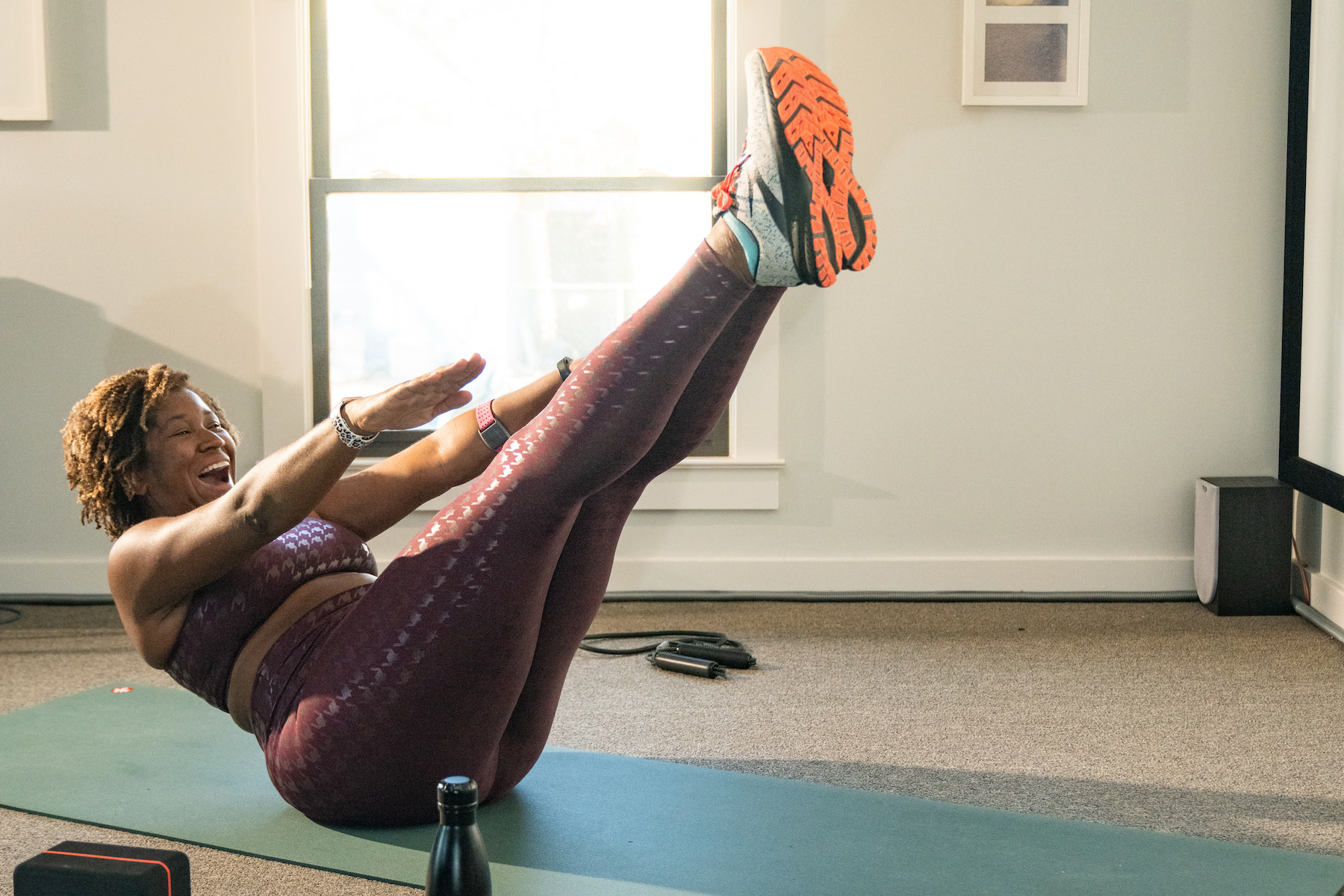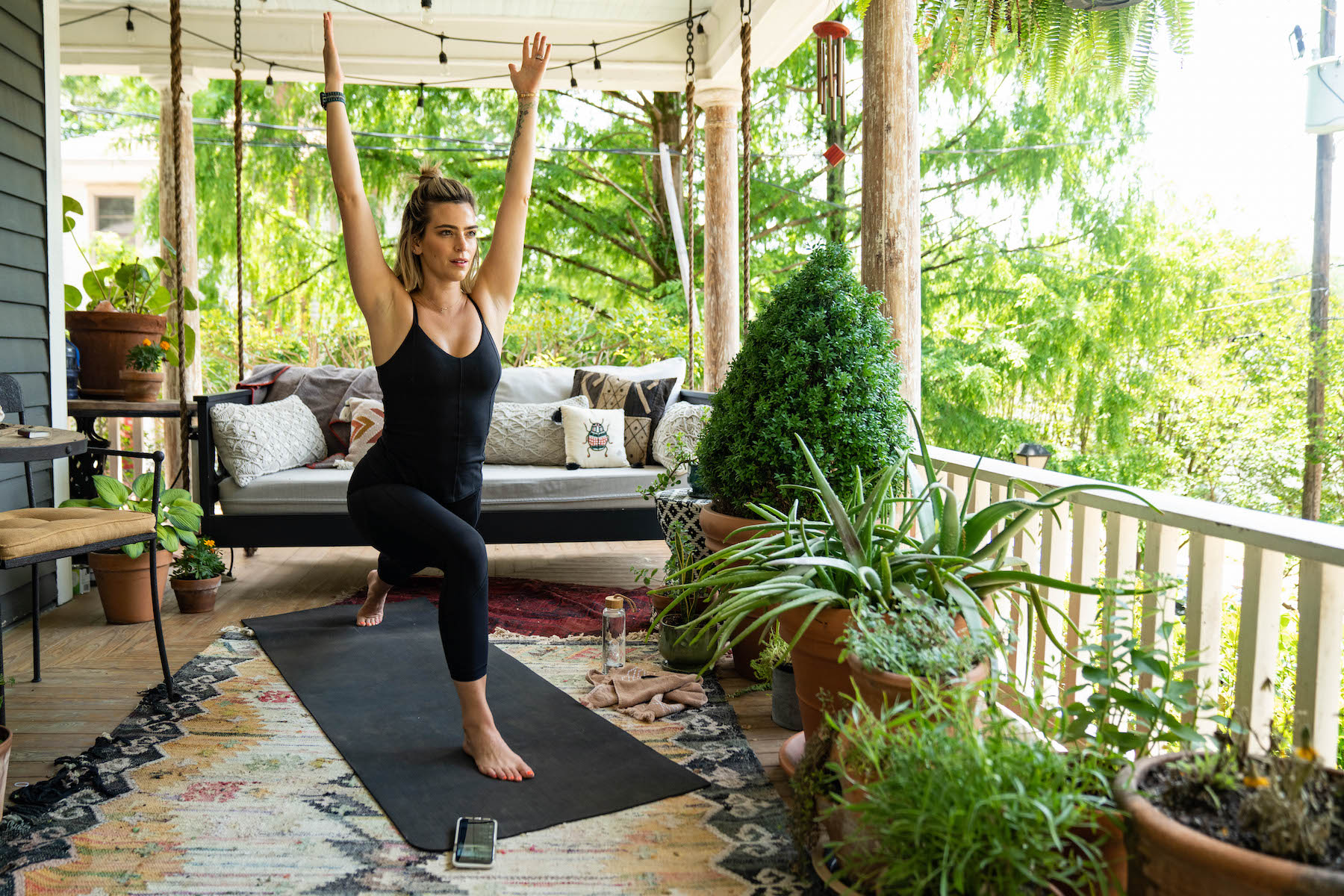
Everything You Need to Start Your At-Home Yoga Practice
Set up your space—and yourself—for success.
By Team Peloton•
Why Create a Special Space for Yoga at Home?
How to Set Aside a Yoga Space
Ideas for Setting Up a Yoga Space at Home
Yoga Accessories for At-Home Yoga Sessions
Get Started with a Beginner-Friendly Yoga Session
Have a Regular Home Yoga Routine
Consider Online Classes to Practice Yoga at Home
Have you ever felt like doing a quick yoga flow to get your body moving during your lunch break at home, but couldn’t figure out where to set up? Is it difficult for you to tap into relaxation mode right next to a pile of laundry and a to-do list that’s a mile long? That shouldn’t stop you from tapping into the benefits of creating a yoga zone where you are most at peace: your own home.
On-demand and live yoga at home allow you to establish your personal practice wherever you are, whenever you want. Ready to get started? Below, learn how to set up your own yoga zone, review the accessories you’ll need, and lay out a few beginner-friendly moves so you can begin your very own at-home yoga journey.
Why Create a Special Space for Yoga at Home?
If you’ve practiced yoga before, you’re probably already aware of the many benefits of yoga, such as increased flexibility, stress management, and better sleep. But you don’t necessarily need to go to a studio to see these results. Practicing yoga at home, even just one day a week, can help you improve your mood, increase your strength, and feel more confident. When you develop an at-home yoga practice, there is also the added perk of eliminating outside distractions, which is a core tenant of yoga. Practicing and meditating in the solitude of your own space allows you to easily tap into the mental portion of your flow, without the need to block out what’s going on with the people around you (except maybe your family!).
How to Set Aside a Yoga Space
Practicing within your own home is probably easier than you think. Whether you have unused space in your home like a guest room or garage, or if you only have a corner, you can easily create a space that will make your at-home yoga practice more effective. A common guideline used by yoga studios is to allocate 21 square feet for each person. That works out to an area of approximately 4.5’ x 4.5’. Got more space? Any extra space beyond that is useful for additional stretching or other movements. Just be sure to move furniture or breakable items nearby.
Ideas for Setting Up a Yoga Space at Home

Chances are you’ve seen many different aesthetic images of at-home yoga spaces in your social media feeds. And while they may look dreamy and aspirational, you can go as simple as you want—or not! Don’t let time or budget hold you back from developing a yoga space that works for you. Just a few small changes can help elevate your mood and allow you to tap into the more tactile aspects of your practice. These tips can help you create a space that’s equal parts motivating and meditative.
Use houseplants to create a relaxing vibe: Gather up your potted plants and arrange them around your yoga space to bring a bit of nature into your practice. This can help you feel more grounded before you even begin.
Tidy up before getting started: If there are distractions in your yoga zone, take a few minutes to clear away any clutter or other items that might distract you during your flow. Think: your laundry basket or that stack of mail.
Free your space of electronics: If you’re using your TV, computer, or phone to take a class on the Peloton App, make that the only electronic device that’s powered on while you’re practicing yoga. This will help preserve the sanctity of your yoga space and allow you to treat your at-home practice seriously.
Maximize comfort with nearby pillows: Keep a comfortable pillow to sit on or place behind your back or under your knees for optimum comfort during meditation and savasana. You may also want a blanket, socks, or a light sweater to throw on during savasana as your body begins to cool down.
Add some mood lighting and incense: Keep artificial light at a minimum during your practice, which can throw off your relaxation. If you don’t have natural light or are practicing in the evening, you can light some candles, use soft lighting, or even plug in a salt lamp.
Use a standing or wall mirror to try out different postures: While not necessary, having a full-length mirror nearby can help you check in with your body and make any necessary adjustments to ensure your posture is aligned.
Yoga Accessories for At-Home Yoga Sessions
The good news? It doesn’t take much in the way of accessories to have a productive flow. All you really need is a yoga mat. Ideally, you should also have access to yoga blocks and a yoga strap, which can help support your body as you deepen into new poses. Keep a water bottle nearby and change into yoga clothes that won’t restrict your movements. Looking for more? Check out these suggested yoga props].
Get Started with a Beginner-Friendly Yoga Session

Now that you’ve set up your space and gathered your accessories, you’re ready to begin your at-home yoga practice. Peloton instructors often recommend beginners try a slow flow class, restorative yoga class, or even a Yin yoga class. Wherever you choose to start, Peloton Yoga instructor Aditi Shah says “A good yoga class will help to mobilize the joints, stretch muscles, tone the organs, strengthen the body, breathe systematically, focus the mind, and so much more.”
Here are a few popular poses to get you started with your yoga at home.
1. Downward-Facing Dog
This pose stretches your hamstrings and strengthens your limbs, in addition to bringing more blood flow to your brain. Begin on your hands and knees, keeping your wrists directly beneath your shoulders. With your toes curled under, push your hips back and straighten your legs, trying to keep your heels as close to the ground as possible. Breathe deeply, and if you feel tightness in your calves, “peddle out” your dog by alternating the bending of your knees. Stay here for a few breaths before moving on with your flow.
2. Crescent Lunge
This pose targets your hip flexors and helps improve balance. Begin by standing at the back of your mat. Step your left leg forward, lowering your right knee and palms to the mat. Inhale, raising your arms above your head. Shift your hips forward and bring your gaze upward to deepen the pose, trying to bring your right thigh a little closer to the floor. Stay here for a few breaths, then repeat on the other side.
3. Tree Pose
This pose can help you strengthen your legs and improve your posture. Begin by standing with your feet pressed firmly into your mat. Inhale, placing your hands at prayer and lifting your right foot to press your sole into your left thigh or calf. Pressing down into your left foot to steady yourself, lift both arms up. Hold for several breaths, then repeat on the other leg.
4. Bridge Pose
This pose will help you strengthen your core. Lie on your back and bend your knees, keeping your feet flat and your arms at your sides, palms down. Inhale, pressing into your feet to slowly lift your hips. Press your heels down to keep your hips lifted and your core tight. Stay here for a few breaths and then slowly lower yourself back down.
5. Savasana
This pose can help your body and mind to wind down. Lie flat on your back, with your palms facing upward. To make it more comfortable, you can place a pillow under your knees. Slowly begin to breathe deeply, allowing your whole body to relax and feel heavy, from the soles of your feet to the top of your head. See if you can stay present here for about 5 minutes.
Have a Regular Home Yoga Routine
It’s important to remember that implementing small changes to your at-home yoga routine will have a big impact. Now that you’ve taken the time to create the space for it, it’s important to be prepared for any roadblocks that will keep you from having a regular in-home yoga routine. Here are some tips for keeping your in-home practice alive and thriving:
Set your Intentions
There is nothing more loving towards yourself than following through on a goal you’ve set for yourself, especially when it pertains to your health and wellbeing. Get really clear with yourself on why you want to have a consistent yoga routine, and write it down so you can remind yourself of your intentions when you’re tempted to skip.
Create a Weekly Schedule
Treat your in-home yoga routine with just as much importance as you would a class or commitment you booked ahead of time. Create a weekly schedule, block off the time you need, set reminders in your phone…do whatever you need to do to make sure you show up for yourself and “attend” your in-home flows.
Prepare Ahead of Time
Once you’ve set your schedule, make sure your yoga zone is prepared ahead of the time you’ve blocked off, so you’re not wasting your time trying to find your mat or clear your space during your dedicated “flow time.” Remember that in the moment you might be looking for excuses to justify skipping your in-home flow, and having everything already prepared helps eliminate at least a few of those internal arguments.
Try an On-Demand Class
Schedule a class for yourself so you have a supportive yoga instructor giving you guidance and walking you through a complete flow. This will help your in-home flow feel much more realistic, and it will help to have an instructor calling out modifications, encouraging you to maintain pose integrity, and helping you check in with your feelings and emotions throughout your practice.
Enlist an Accountability Buddy
You don’t have to invite a friend into your personal yoga zone, but it might help to get a few buddies on board to check in with each other and make sure you are all completing your yoga practices and following through on your intentions. Having a group chat that will have your back and pump you up to follow through can make all the difference as you form this new, incredible habit! If you’re using the Peloton App, you can also use the Invite Friends feature to plan classes with your crew.
Consider Online Classes to Practice Yoga at Home
Now that you’ve built a proper space for your at-home yoga practice, you can start exploring the Peloton App to find some yoga classes that are right for you, given your time constraints and fitness level. You will find yoga classes for different needs, such as foundations, power classes, slow flows, and even guided meditations. And the best part is that you can start your at-home yoga journey in a comfortable and peaceful environment. By dedicating a space for yoga at home, you’re making it easy for you have to regular mat time.
This content is for informational and educational purposes only and does not constitute individualized advice. It is not intended to replace professional medical evaluation, diagnosis, or treatment. Seek the advice of your physician for questions you may have regarding your health or a medical condition. If you are having a medical emergency, call your physician or 911 immediately.
LEVEL UP YOUR INBOX.
Subscribe for a weekly dose of fitness, plus the latest promos, launches, and events.
By providing your email address, you agree to receive marketing communications from Peloton.
For more about how we use your information, see our Privacy Policy.


